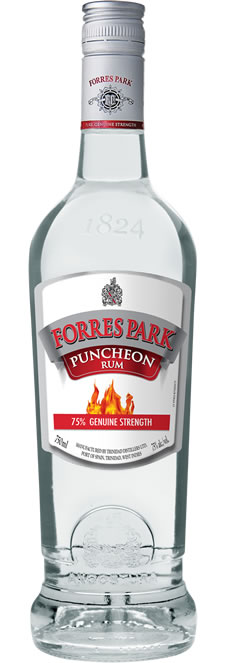
Photo from Angostura website
What’s surprising about this white triple-filtered column-still overproof – which keeps company with 151s like the Bacardi or Cavalier and others – is that it is not a complete fail, though it does resemble a massive ethanol delivery system that forces you to consider whether a visit to your place of worship is required before it comes alive and does a chestburster on your mosquito physique. It has a few points of interest about it, in spite of its fiery heat and hard punch…and I say that grudgingly, because overall, I don’t see much to shout about.
Part of the problem is the indifference with which – to me – it seems to be made. I blame the triple filtration for this state of affairs. No real effort appears to have been pushed into elevating it beyond a high proof cocktail ingredient (rather, such effort seems to have been directed towards muting the flavours rather than enhancing them), and one gets this impression right away when (very carefully) nosing it, where the lack of any real complexity is disappointing. Oh sure, it’s hot and sharp and very intense, but what did you expect? And what do you get for your trouble? — not much beyond sugar water, a few briny notes, some red olives and a small amount of acetones and coconut shavings. And maybe a green grape or two. In short, as West Indians would say, mek plenty plenty noise, but ain’ got enuff action.
The palate is usually where such overproofs really get into gear, pump up the revs and start laying rubber on your face. Certainly that happened here: as a lip-burn and tongue-scorcher, it’s tough to beat. It presented as very oily and briny and what sweet there was sensed on the nose vanished like a fart in a high wind. There were tastes of dates, figs, soya and vegetable underlain with a weird kind of petrol undertone (quite faint, thankfully). Some nail polish and new paint slapped over freshly sawn lumber – but very little in the way of fruitiness, or a more solid underpinning that might make it a more interesting neat pour. And the heat just eviscerates the finish, which, although giving some more sweet and salt, sugar water, soya, watermelon (at last – something to praise!), is too faint and dominated by the burn to be really satisfying.
Of course, this is a rum not meant to have by itself – few rums boosted to 75% and over really are, they’re meant for bartenders, not barflies. Too, stuff at that strength is treading in dangerous waters, because there are really only two options open to it: don’t age it at all (like the Neisson L’Esprit 70° Blanc and Sunset Very Strong 84.5%) and showcase as much of the youthful vigour and original taste as one can; or age it a little – not the one or two years of the Bacardi 151, but something more serious, like the SMWS Longpond R5.1 81.3% or the Barbados R3.5 74.8% or the really quite good R3.4 75.3%.
As a puncheon, named after the oversized barrels in which they were stored, this was developed in the early part of the last century as a cheap hooch for the plantation workers and the owners. It was never really meant for commercial sale – yet for some reason it turned out so popular that the Fernandes (the family enterprise which originally made it on the Forres Park estate) issued it to market, and even after Angostura took over the company, they kept it as the only entrant in the insane-level-of-proof portion of their portfolio.
Like all rums brewed to such heights of strength, it sustains a level of intensity that most full-proof rums can barely maintain for even five minutes, just without many (or any) of their redeeming features. That’s part of the problem for those who want a neat and powerful drink that’ll fuel their car or blow their hair back with equal ease – because there’s a difference between an overproof that uses extreme strength to fulfill an artistic master blender’s purpose, as opposed to one that just issues it because they can’t think of anything better to do. Unfortunately, here, this is a case of the latter being taken a few steps too far.
(#525)(73/100)
Other notes
- While the Forres Puncheon I review here is made by Angostura, its antecedents date back much further, to the original company that created it, Fernandes: and that was so fascinating that I have devoted a separate biography of the Angostura-acquired Fernandes Distillery to it, as it was too lengthy for inclusion in this review.
- Sample provided by my correspondent Quazi4moto, who’s turned into something of a rum fairy of samples these days. Big hat tip to the man.